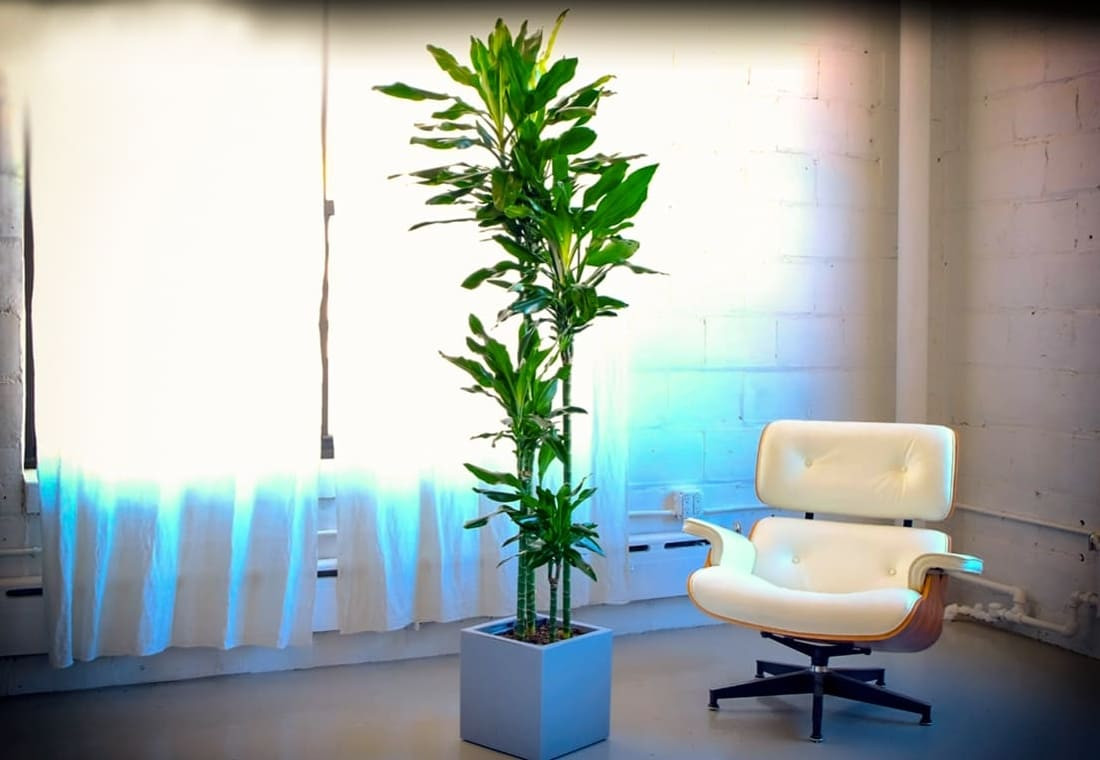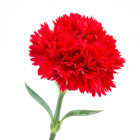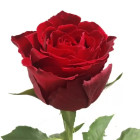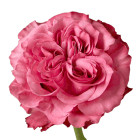
Dracaena – Care and Plant Features by Flora Market
Dracaena, a member of the Asparagus family, is one of the most popular houseplants. It can appear as a shrub or a tree with long, narrow leaves, which can be solid green or decorated with stripes and spots. In indoor conditions, dracaenas usually reach a height of 50 cm to 3 meters, depending on the species. The plant is known for its hardiness and decorative qualities, making it ideal for home and office cultivation.
Flower shop owners and florists appreciate it for its resilience to various growing conditions and long lifespan. This plant is perfect for interior design as it can adapt to different levels of light and temperature. Houseplant enthusiasts choose dracaena for its ability to purify the air and bring coziness to any room.
History and Origin
Origin of Dracaena
The native habitat of dracaena includes tropical and subtropical regions of Africa, Asia, and Central America. In the wild, dracaenas can reach impressive sizes, with some species growing up to 20 meters tall. These plants inhabit forests, rocky slopes, and even savannas, demonstrating their adaptability to various climatic conditions.
Legends and Myths Associated with the Plant
The name "dracaena" comes from the Greek word "drakaina," which means "female dragon." This is associated with the bright red resin some dracaena species produce, known as "dragon's blood." According to one legend, a warrior, in love with a chief's daughter, was challenged to plant a stick in the ground, which, if sprouted, would allow him to marry her. Miraculously, the stick did grow, turning into a dracaena, making the plant a symbol of love and fidelity.
The Significance of Dracaena in Culture and Folklore
In different cultures, dracaena holds various meanings. In African traditions, "dragon's blood" was used in rituals and medicine, considered magical and healing. In China, dracaena is given at weddings, believed to bring happiness and prosperity to married life. In Europe, dracaena is called the "tree of happiness" and is often used to create a good atmosphere in the home and attract good luck. Besides its cultural significance, dracaena is also recognized for its ecological qualities, effectively purifying the air from harmful substances such as formaldehyde and benzene.
Types of Dracaena
There are various types and varieties of dracaena, each with its unique characteristics and care requirements. Let's consider the most popular ones.
Dracaena Marginata
Dracaena marginata, or the Madagascar Dragon Tree, is one of the most popular dracaena species. It has narrow, long leaves that can reach up to 70 cm in length. The leaves are dark green with a reddish-brown edge. This species is often grown as a decorative plant in homes and offices due to its elegant appearance and ability to adapt to various lighting conditions. Dracaena marginata can grow up to 3 meters tall with proper care.
Dracaena Sanderiana
Dracaena sanderiana, also known as "Lucky Bamboo," is a compact shrub often sold in twisted or bundled stems resembling bamboo. Its leaves are narrow, light green, sometimes with yellowish stripes. The plant usually does not exceed 1 meter in height. Dracaena sanderiana is perfect for small spaces and is often used in Feng Shui compositions.
Dracaena Fragrans
Dracaena fragrans, also known as the "Corn Plant," got its name due to its fragrant flowers, which it occasionally produces in natural conditions. In indoor conditions, flowering is rare. This species has broad, glossy leaves that can reach up to 1 meter in length and 10 cm in width. The leaves are often adorned with yellow or white stripes. Dracaena fragrans can grow up to 2 meters tall and is considered one of the most beautiful decorative plants.
Dracaena Draco
Dracaena draco, or the Dragon Tree, is distinguished by its robust, woody trunk and stiff leaves that grow in rosettes at the top. This species can reach impressive sizes in the wild, growing up to 20 meters tall, but in home conditions, it usually does not exceed 1-2 meters. The leaves of Dracaena draco are gray-green with spines along the edges. It is known for its reddish sap, called "dragon's blood."
Dracaena Godseffiana
Dracaena godseffiana, also known as the "Gold Dust Dracaena," has unusual oval leaves covered with white or cream spots. This low shrub reaches about 60 cm in height. Thanks to its bright coloration, Dracaena godseffiana is often used to create accents in interior design. It prefers diffused light and requires regular watering.
Each of these dracaena species brings its unique aesthetic and atmosphere to a home or office, making them an ideal choice for those who value beauty and ease of care.
Growing Conditions
Lighting
Dracaenas prefer bright, diffused light but can also grow in partial shade. Direct sunlight can cause leaf burns, so it should be avoided. The optimal place for a dracaena is an east or west window, where it will receive enough light without the risk of overheating.
Light Requirements for Different Types of Dracaena
- Dracaena Marginata: Grows well in bright, diffused light but can tolerate partial shade.
- Dracaena Sanderiana: Needs moderate lighting, does well in diffused light.
- Dracaena Fragrans: Prefers bright light but without direct sunlight.
- Dracaena Draco: Tolerates bright, diffused light, sometimes can withstand direct sunlight.
- Dracaena Godseffiana: Requires bright, diffused light. In the shade, the leaves lose their brightness.
Temperature Regime
Optimal Temperature in Different Seasons
Dracaenas grow well at moderate temperatures. In summer, the optimal temperature is 20-25 °C, in winter – 16-18 °C. It is important to avoid temperature fluctuations and provide stable conditions.
Protection from Drafts and Sharp Temperature Changes
Dracaenas are sensitive to drafts and sharp temperature changes. Plants should be placed in locations where they will be protected from direct exposure to cold air, especially in winter. For example, they can be moved away from windows and doors or use screens to protect from drafts.
Air Humidity
Most dracaena species prefer moderate to high air humidity. Lack of humidity can lead to dry leaf tips and other problems.
Methods of Air Humidification
To maintain optimal humidity, you can use the following methods:
- Regularly mist the leaves with water.
- Place plant pots on trays with wet gravel or clay pebbles.
- Use humidifiers in the room.
- Place open containers of water or decorative fountains near the plants.
Watering and Leaf Care
Frequency and Volume of Watering
In summer, dracaena should be watered more frequently, about once a week, to keep the soil moderately moist. In winter, watering is reduced to once every two weeks, as the plant consumes less water during this period. It is important to let the soil dry out slightly between waterings to avoid overwatering.
How to Avoid Overwatering and Underwatering
To prevent overwatering and underwatering:
- Use pots with drainage holes to allow excess water to escape.
- Check soil moisture before each watering using your finger or a moisture meter.
- Adjust the amount of water according to the season and indoor conditions.
Leaf Care
Cleaning Dust from Leaves
Dracaena leaves should be regularly cleaned from dust. Use a soft, damp cloth or sponge. Cleaning helps improve photosynthesis and prevents pests.
Misting and Bathing
Misting the leaves with water helps maintain humidity and prevent drying out. This should be done every few days, especially in winter when indoor air becomes dry due to heating.
Bathing under a warm shower is also an effective way to clean and hydrate. It is important to cover the pot with plastic to prevent water from entering the soil. After bathing, gently remove excess moisture from the leaf rosettes to avoid rot.
These recommendations will help keep your dracaena healthy and attractive, providing it with comfortable conditions for growth and development.
Dracaena Transplanting
When and How to Transplant
Initial Transplant After Purchase
After purchasing a dracaena, it is recommended to perform the initial transplant within 10-14 days. This allows the plant to acclimate to new conditions. Transplanting helps check the root system's condition and replace the transportation substrate with more suitable soil.
Regular Transplanting of Young and Mature Plants
Young dracaenas should be transplanted annually, while mature plants over 5-6 years old should be transplanted every 2-3 years. Signs that a plant needs transplanting include:
- Roots growing out of drainage holes.
- Soil drying out quickly after watering.
- The plant becomes unstable due to root system growth.
Choosing Pots and Soil
Pot Selection Recommendations
Dracaenas do best in pots with drainage holes to avoid water stagnation. The new pot should be only slightly larger than the previous one, by 1-2 sizes, to prevent overwatering.
Optimal Soil Composition
For transplanting dracaena, use light, well-drained substrate. You can use a ready-made palm soil or mix the following components:
- 2 parts leaf soil
- 1 part sand or perlite
- 1 part humus
Transplanting Process
- Water the dracaena the day before transplanting.
- Carefully remove the plant from the old pot.
- Check the root system and remove damaged or rotten roots.
- Place the plant in a new pot, adding a layer of fresh soil at the bottom.
- Fill the space around the roots with new soil and water the plant.
Care After Transplanting
After transplanting, dracaena requires:
- Maintaining moderate soil moisture.
- Placing the plant in a bright, diffused light area.
- Avoiding fertilization for a month after transplanting, then applying liquid fertilizers monthly during the active growth period.
Fertilization and Feeding
Frequency and Types of Fertilizers
For healthy dracaena growth, regular feeding is essential. During the active growth period (spring to autumn), feed the plant every two weeks. Use liquid fertilizers for houseplants.
Fertilizer Recommendations for Different Seasons
- Spring and Summer: During the active growth period, apply liquid fertilizers every 2 weeks. This can be a universal houseplant fertilizer or a special palm fertilizer.
- Autumn and Winter: In the cold season, reduce or stop feeding, as the plant enters dormancy and nutrient requirements decrease.
How to Fertilize Properly
- Dilute the fertilizer according to the package instructions.
- Water the plant before applying fertilizer to avoid root burns.
- Evenly distribute the fertilizer over the soil surface.
- Regularly monitor the plant's condition and adjust feeding frequency and concentration as needed.
Following these recommendations will help your dracaena stay healthy and beautiful throughout the year.
These tips and instructions will help you provide optimal conditions for the growth and development of your dracaena, making it a beautiful decoration for your interior.
Dracaena Propagation
Propagation Methods
Dracaena can be propagated in several ways: cuttings, seeds, and layering. Each method has its features and is suitable for different types of dracaena.
Cuttings
Cuttings are the most common and easiest method of propagating dracaena. There are two types of cuttings: apical and stem cuttings.
- Apical Cuttings: For this method, choose a strong, healthy stem and cut the top 10-15 cm long. The lower cut is treated with a rooting stimulant (e.g., Kornevin) and buried 2-4 cm in a light substrate. The pot with the cutting is covered with a plastic bag with several ventilation holes and placed in a bright, warm place. After about a month, new roots and leaves begin to appear, after which the cover can be removed.
- Stem Cuttings: The stem is cut into several segments 5-7 cm long, each with several buds. The cuttings are laid horizontally on the substrate surface and covered with a layer of soil about 2 cm thick. The pot is covered with film and placed in a warm place until shoots appear.
Seed Propagation
Seed propagation is less popular because it is a longer and more labor-intensive process. Dracaena seeds are sown in a light substrate at a temperature of 25-28 °C and high humidity. The container is covered with a film to create a greenhouse effect. Seedlings appear in 45-60 days. This method is more often used for rare types of dracaena, such as Dracaena Godseffiana.
Layering
Layering is a convenient method for dracaena. For this, the top of the stem is cut off and placed in a glass of clean water with an activated charcoal tablet for disinfection. Roots appear in 1-3 months, after which the plant can be transplanted into a separate pot with soil. You can also root side shoots that form after pruning.
Step-by-Step Propagation Instructions
- Preparation: Choose a healthy stem or plant top.
- Cutting: Use a sharp knife to cut 10-15 cm cuttings.
- Treatment with Stimulant: Treat the lower cut of the cutting with Kornevin.
- Planting: Plant the cutting in a light substrate or place it in water with activated charcoal.
- Creating Conditions: Cover the pot with film and place it in a warm, bright place.
- Care: Regularly ventilate and maintain humidity.
- Transplanting: After roots appear, transplant the plant into a separate pot.
Disease and Pest Control
Common Dracaena Diseases
- Alternaria: Appears as dry spots with a light center on the leaves and stems, which gradually turn black. Treatment is carried out by spraying with copper-containing fungicides or Fundazole, with treatments done 3 times at intervals of 10 days.
- Tomato Spotted Wilt Virus: Infected plants lag in growth, young leaves deform and develop brown spots. There is no cure; plants are destroyed.
- Phyllosticta: Affects leaves, leaving large pale brown spots with a yellow-green border that dry quickly. To protect the plant, use fungicides Topaz and Oxyhom.
Pests and Control Methods
- Mealybugs: Leave cotton-like waxy deposits on leaves and stems. Wash plants under a shower with soapy water, then spray with Aktara or Actellic, repeating treatment after 10-14 days.
- Spider Mites: Infest plants in dry and warm air. Treat leaves with Akarin, Bicol, or Fitoverm twice at 14-day intervals.
- Thrips: Small insects that feed on plant sap, leaving gray-brown spots with a silvery sheen on leaves. Spray plants with Actellic 2-3 times at weekly intervals.
- Scale Insects: Affect leaves, stems, and branches, causing them to wilt. Remove insects with a cotton swab dipped in alcohol, then wash the plant with soapy water and spray with Actellic.
How to Identify and Eliminate Pests
Pests can be identified by characteristic signs: yellow spots on leaves (spider mites), cotton-like deposits (mealybugs), brown scales (scale insects), and sticky residue (aphids). Control methods include soapy solutions, insecticides, and regular spraying.
By following these recommendations, you can effectively propagate dracaena and protect it from diseases and pests, ensuring healthy growth and development.
Interesting Facts About Dracaena
- Dracaena can purify the air from harmful substances like formaldehyde, benzene, and trichloroethylene. This property has placed the plant on NASA's list of best air-purifying plants.
- Some dracaena species can reach up to 20 meters in height in nature and can live for hundreds of years.
- The name "dracaena" comes from the Greek word "drakaina," meaning "female dragon," associated with the reddish sap of some species resembling the blood of a mythical creature.
- Dracaena adapts well to indoor conditions and can grow even in low light, making it an ideal plant for offices and living spaces.
Benefits of Dracaena for Health and Interior
Dracaena not only decorates interiors but also brings significant health benefits. The plant effectively purifies the air from toxins, improving indoor air quality and creating a healthier environment. This is particularly important in urban settings where air quality often leaves much to be desired.
Additionally, dracaena helps humidify the air, which is beneficial for the skin and respiratory system, especially in winter when indoor air becomes dry due to heating systems. Having green plants like dracaena also positively impacts mental and emotional well-being, reducing stress levels and improving mood.
Conclusion
Dracaena is an amazing plant that combines beauty and practical benefits. It is easy to care for, resilient to various conditions, and can delight the eye with its exotic appearance. The variety of species and varieties allows you to choose a plant suitable for any interior and lighting level.
Tips for Dracaena Care
- Lighting: Place the plant in a spot with bright, diffused light, avoiding direct sunlight.
- Temperature: Maintain a temperature of 20-25°C in summer and 16-18°C in winter.
- Air Humidity: Regularly mist the leaves and use humidifiers.
- Watering: Water the plant when the top layer of soil dries out by 2-3 cm, avoiding overwatering.
- Feeding: During the active growing season (spring to autumn), feed the plant with complex fertilizers every two weeks.
Dracaena is an excellent choice due to its unpretentiousness and decorative appeal. It is perfect for creating compositions and decorating interiors. Plant enthusiasts can enjoy its beauty and ease of care, as well as its positive impact on health and home atmosphere.
Creating a cozy corner with dracaenas brings a piece of the tropics into your home, improves air quality, and creates a pleasant atmosphere for work and relaxation. May your plant be healthy and beautiful, delighting you and your loved ones for many years.
FAQ
How to care for dracaena?
- Place in a spot with bright, diffused light.
- Maintain a temperature of 20-25°C in summer and 16-18°C in winter.
- Regularly mist the leaves and use humidifiers.
How often to water dracaena?
- Water when the top layer of soil dries out by 2-3 cm. In summer, water once a week; in winter, less often.
What are the popular dracaena species?
- Dracaena marginata, Dracaena sanderiana, Dracaena fragrans, Dracaena draco, Dracaena godseffiana.
How to transplant dracaena?
- Transplant in spring, choose a pot 1-2 sizes larger, use light, well-drained soil.
How to fertilize dracaena?
- During the active growing season (spring-summer), every two weeks with complex liquid fertilizers.
What diseases affect dracaena?
- Alternaria, Tomato Spotted Wilt Virus, Phyllosticta.
How to deal with pests on dracaena?
- Mealybugs, spider mites, thrips, scale insects. Use insecticides and regular spraying with soapy water.











